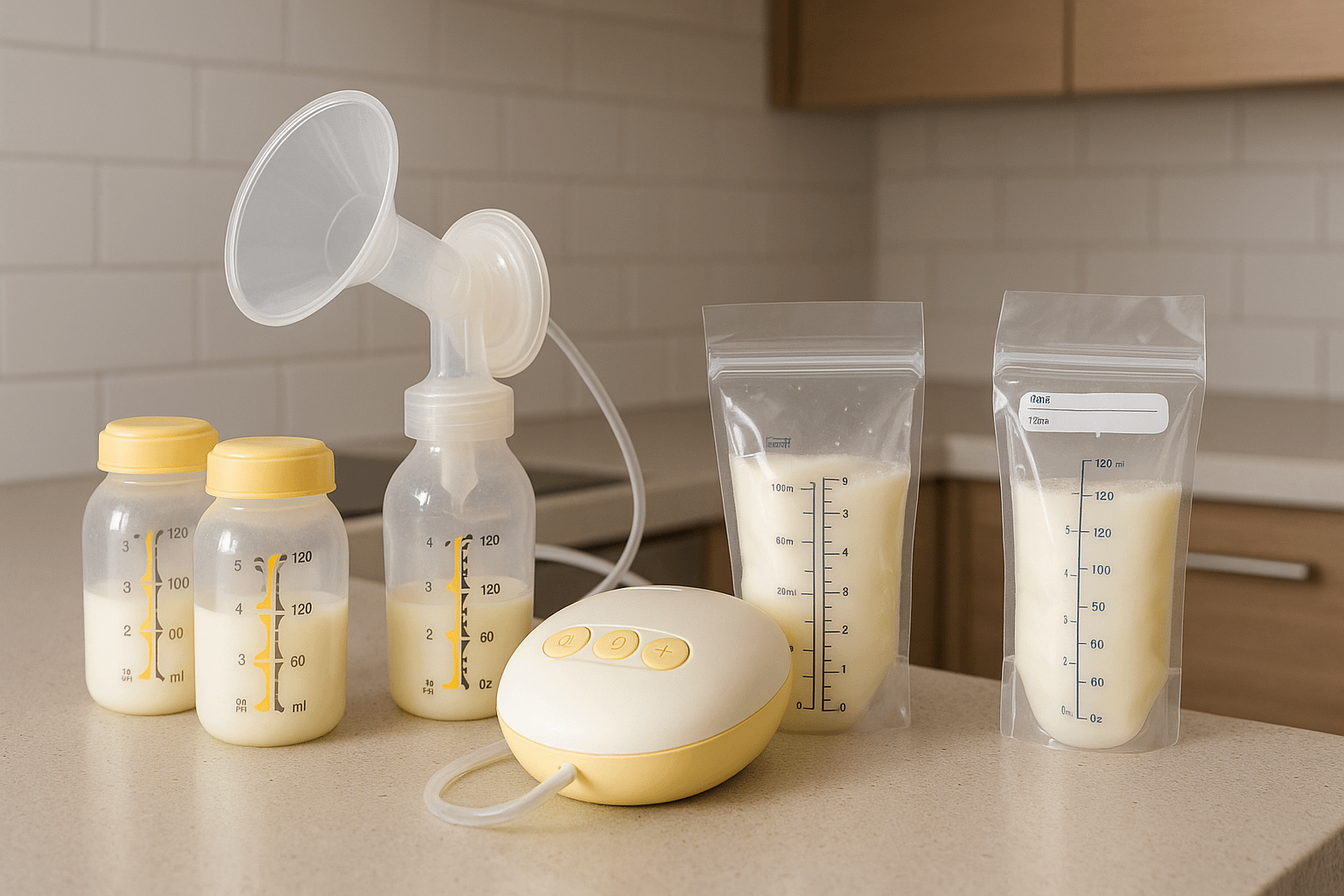Introduction to Expressing Breast Milk
Expressing breast milk has become an essential part of modern parenthood. For some mothers, it’s a way to continue breastfeeding while returning to work. For others, it helps share feeding responsibilities, build a milk supply, or provide nutrition when direct breastfeeding isn’t possible. Whatever the reason, navigating the world of pumps, storage guidelines, and feeding schedules can feel overwhelming at first.
This comprehensive guide explores the practicalities of expressing breast milk, with an emphasis on evidence-based information, real-world applications, and strategies for balancing breastfeeding with the demands of everyday life.
The Rise of Expressing Breast Milk
Breastfeeding has long been recommended by the World Health Organisation (WHO) and the NHS as the optimal source of nutrition for infants, providing immunity benefits and essential nutrients. But lifestyle changes, workplace demands, and medical circumstances mean exclusive breastfeeding isn’t always feasible.
In the UK, breastfeeding initiation rates are high, but only around a third of babies are exclusively breastfed at six weeks. Expressing breast milk offers flexibility, allowing mothers to continue providing breast milk even when they cannot always nurse directly.
From manual pumps used sporadically in the 20th century to today’s high-tech wearable pumps, expressing has evolved into a sophisticated and widely supported practice.
Choosing the Right Pump
Disclosure: As an Amazon Associate, I earn from qualifying purchases. This means that if you click on a link and make a purchase, I may receive a small commission at no additional cost to you.
Manual vs Electric Pumps
- Manual pumps: Affordable, portable, and quiet, but best suited for occasional expressing.
- Single electric pumps: Faster and more efficient, often a good choice for mothers expressing once or twice a day.
- Double electric pumps: Extract milk from both breasts simultaneously, cutting expressing time in half and boosting supply for frequent users.
- Wearable/Hands-free pumps: Discreet, battery-operated devices that slip into a bra, allowing mobility during pumping, ideal for working mothers or frequent expressers.
Key Factors to Consider
- Comfort: A well-fitting flange is critical to avoid pain and ensure effective milk removal.
- Noise level: Important for those expressing at work or in shared spaces.
- Portability: Battery-powered pumps offer greater flexibility than mains-only options.
- Cleaning: Models with fewer parts simplify sterilisation and daily maintenance.
Safe Storage of Breast Milk
Proper storage maintains milk’s nutritional quality and prevents bacterial contamination. Guidelines may vary slightly, but NHS and WHO standards provide clear benchmarks.
- Room Temperature (up to 25°C): Up to 6 hours.
- Refrigerator (≤4°C): Up to 5 days.
- Freezer (–18°C or colder): 6 months is ideal; up to 12 months if necessary.
- Defrosted Milk (in fridge): Use within 24 hours; never refreeze.
- Warmed Milk: Use within 2 hours; discard leftovers.
Practical Tips
- Label containers with the date and time of expression.
- Store milk in small portions (60–120 ml) to reduce waste.
- Use breast milk storage bags or sterilised bottles.
- Thaw in the fridge or warm water, never in a microwave, which can create hot spots.
Building a Pumping Schedule
A pumping schedule depends on whether a mother is exclusively expressing, combining nursing with pumping, or building a freezer stash.
Exclusive Pumping
Mothers who exclusively pump typically express 8–10 times per day in the early weeks, mimicking a newborn’s feeding pattern. Over time, many reduce to 6–8 sessions daily, maintaining supply while balancing lifestyle demands.
Working Mothers
- Before Work: Pump in the morning when the supply is highest.
- During Work: Aim for 2–3 sessions, depending on hours and the infant’s age.
- After Work, Nurse directly or pump again to maintain the supply.
Employers in the UK are increasingly providing lactation rooms, but access varies. Planning ahead, including storing pump parts in a cooler bag, helps streamline the process.
Supplementing Direct Breastfeeding
Some parents pump once daily, often in the morning, to build a freezer reserve while primarily nursing directly.
Common Challenges and Solutions
- Low Supply: Power pumping (short bursts over an hour) can stimulate production. Adequate hydration, rest, and consistent sessions are also important.
- Blocked Ducts or Mastitis: Gentle massage, warm compresses, and frequent emptying help reduce risks.
- Returning to Work Stress: Gradual introduction of bottles before maternity leave ends eases the transition for both mother and baby.
- Pump Discomfort: Trying different flange sizes or lubricating with nipple cream can improve comfort.
Expressing on the Go
Travel, social commitments, and unpredictable schedules make mobile expressing a necessity. Portable pumps, cooler bags with ice packs, and insulated flasks of hot water (for warming bottles) are invaluable. Some airports, train stations, and shopping centres now provide family rooms with facilities for pumping, though availability is inconsistent.
For long-haul flights, parents should check airline policies in advance. Some carriers allow breast pumps on board as medical devices, and cabin crew are usually supportive when space is needed.
Expressing and Family Dynamics
Expressing is not just a physical act but an emotional one. It allows partners, grandparents, and carers to share feeding responsibilities, strengthening bonds with the baby. For many mothers, expressing can relieve the pressure of being the sole source of feeding and enable greater flexibility, whether for professional, medical, or personal reasons.
Looking Ahead: Technology and Policy
The breast pump industry has grown into a multi-billion-pound market, with innovations focusing on wearable devices, quieter motors, and app-connected data tracking.
At the same time, workplace legislation and cultural attitudes are shifting. While the UK has fewer formal protections compared to countries like the US (with the 2023 PUMP Act), awareness of breastfeeding rights in public and professional spaces is increasing. The expansion of workplace lactation facilities remains a key issue for supporting families.
Final Thoughts
Expressing breast milk bridges the gap between the biological act of nursing and the modern realities of parenting. With the right pump, safe storage practices, and a workable schedule, families can find a rhythm that supports both the baby’s nutrition and the caregiver’s well-being.
For mothers balancing personal health, professional commitments, and family life, expressing isn’t just about milk – it’s about freedom, flexibility, and empowerment.

FAQs About Expressing Breast Milk
When should I start expressing breast milk?
Many parents wait until breastfeeding is well-established, usually after the first 4–6 weeks, before introducing regular pumping. However, you can express earlier if your baby is premature, has latching difficulties, or if you need to build a milk supply.
How often should I pump to maintain my milk supply?
To mimic a newborn’s feeding schedule, aim to pump 8–10 times in 24 hours for a newborn, including once at night. As your baby grows, you can gradually reduce sessions while maintaining output.
Which breast pump is best: manual or electric?
Manual pumps are affordable, portable, and good for occasional use. Electric pumps, especially double electric models, are ideal for frequent expressing and can save significant time. Hospital-grade pumps are recommended for low milk supply or exclusive pumping.
How long does expressed breast milk last?
UK guidance suggests:
Room temperature (up to 25°C): Up to 4 hours
Refrigerator (≤4°C): Up to 4 days
Freezer (-18°C or lower): Up to 6 months
Always label milk with the date and use the oldest first.
Can I mix freshly expressed milk with refrigerated milk?
Yes, you can combine milk expressed at different times, but cool fresh milk in the fridge first before mixing it with already chilled milk. Avoid adding warm milk to frozen milk.
What’s the safest way to defrost and warm breast milk?
Defrost milk overnight in the fridge or place the sealed container in warm water. Never use a microwave, as it can create hot spots and damage nutrients.
How can I store expressed milk when travelling or at work?
Use an insulated cooler bag with ice packs to keep milk cold for up to 24 hours. Transfer to a fridge or freezer as soon as possible. Portable coolers and storage bags are handy for commuting parents.
How do I create a pumping schedule that works for me?
Align sessions with your baby’s feeding pattern: every 2–3 hours in the newborn phase, reducing to every 3–4 hours as they grow. Consistency is key for maintaining supply. Some parents find a “power pumping” session helpful to boost production.
Should I sterilise pump parts after every use?
Wash all pump parts in hot, soapy water after each use and sterilise once daily. Many parents use a microwave or cold-water steriliser. Follow the pump manufacturer’s cleaning guidance.
How do I know if my expressed milk is still good?
Fresh breast milk has a sweet smell. Sour or rancid odours indicate it has spoiled. Always check the storage time and look for changes in colour, texture, or separation.
Sources and Further Reading
- NHS — Breastfeeding and Expressing Milk
- NHS — Storing Breast Milk Safely
- World Health Organisation (WHO) — Infant and Young Child Feeding
- The Breastfeeding Network (UK) — Expressing and Returning to Work
- UNICEF UK — Baby Friendly Initiative (Breastfeeding Resources)
- How to Prepare Your Home for a Newborn: A Complete Guide for Expectant Parents
- Formula Feeding: What You Need to Know
- Your Go-To Guide for Breastfeeding Success
- Understanding Baby Sleep Cycles: A Comprehensive Guide for Parents
- Building a Bond with Your Baby
“Best Standard Electric Breast Pump” by Parents magazine.

Spectra S2 Plus Electric Breast Pump
This hospital-grade breast pump is designed to bring confidence and comfort to your breastfeeding journey. Its powerful yet gentle suction mimics a baby's natural suckling, ensuring effective and comfortable pumping sessions.
Key Features:
- Hospital-Strength Suction: Provides strong, efficient milk expression.
- Ultra-Quiet Motor: Perfect for discreet pumping, day or night.
- Closed System: A hygienic barrier protects your milk from contaminants.
- Customizable Settings: Easily adjust suction and speed to find what's most comfortable for you.
- Built-in Nightlight and Timer: Convenient features for those late-night sessions.

